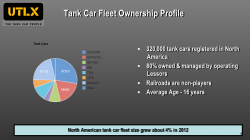As I understood railroad companies built the infamous DOT-111 tankers to be cheap and reliable, but not resistant to derailment or impact. They never expected them to be used in very large amounts in trains as they are now. Typical short-sighted view led by corporate greed.
There were new specs/standards issued for the DOT-111 tanker design in 2011, that made the cars stronger, but nothing was done to the older, existed DOT-111s already in service, that are likely to remain in service for some time.
Historically speaking, the U.S. railroads have "interesting" record in regards to how both freight and passenger cars were designed and implemented -- cheap construction techniques almost always won out over safety.
During WWI, the nation's railroads were briefly nationalized, under the control of the United States Railroad Administration (USRA). One of the major projects the USRA took on was creating a series of designs for locomotives and freight/passenger equipment that would bring the country's railroads "up to snuff". If not for these designs, the American railroads would have drug their feet for many more decades.
But then too, the tracks themselves of American railroads always been of inferior design when compared to most railroads of the world. The American approach was to construct roadbed as cheaply as possible, then make up for a (cheaply built) very rough-riding track by improving the design of the "trucks", the wheel assemblies that the railroad cars road upon.
Continuous welded rail, more commonly called "ribbon rail", is now used extensively on U.S. railroad mainline trackage. Before that, the rail was rarely longer than 40 foot in length. Now, the rails are about 1/4 mile in length. It's more expensive to lay than the old jointed tracks were , but is has lower maintenance costs.
Unfortunately, the iron rail expands and contracts with temperature extremes, thus the track can become distorted, which can cause derailments.




